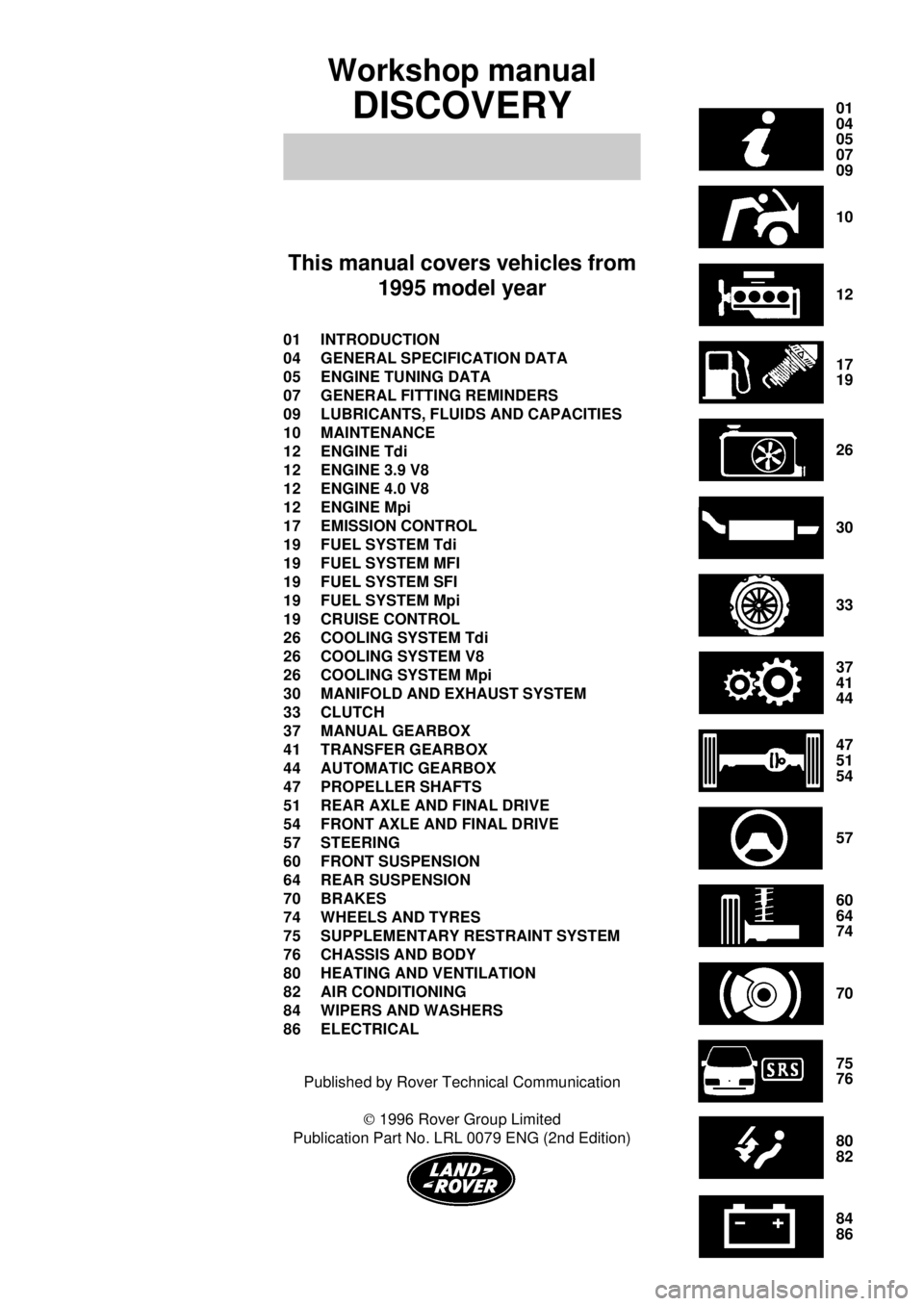air suspension LAND ROVER DISCOVERY 1995 Service Repair Manual
[x] Cancel search | Manufacturer: LAND ROVER, Model Year: 1995, Model line: DISCOVERY, Model: LAND ROVER DISCOVERY 1995Pages: 976, PDF Size: 14.57 MB
Page 2 of 976

01
04
05
07
09
10
12
17
19
26
30
33
37
41
44
47
51
54
57
60
64
74
70
75
76
80
82
84
86
Workshop manual
DISCOVERY
This manual covers vehicles from
1995 model year
01 INTRODUCTION
04 GENERAL SPECIFICATION DATA
05 ENGINE TUNING DATA
07 GENERAL FITTING REMINDERS
09 LUBRICANTS, FLUIDS AND CAPACITIES
10 MAINTENANCE
12 ENGINE Tdi
12 ENGINE 3.9 V8
12 ENGINE 4.0 V8
12 ENGINE Mpi
17 EMISSION CONTROL
19 FUEL SYSTEM Tdi
19 FUEL SYSTEM MFI
19 FUEL SYSTEM SFI
19 FUEL SYSTEM Mpi
19 CRUISE CONTROL
26 COOLING SYSTEM Tdi
26 COOLING SYSTEM V8
26 COOLING SYSTEM Mpi
30 MANIFOLD AND EXHAUST SYSTEM
33 CLUTCH
37 MANUAL GEARBOX
41 TRANSFER GEARBOX
44 AUTOMATIC GEARBOX
47 PROPELLER SHAFTS
51 REAR AXLE AND FINAL DRIVE
54 FRONT AXLE AND FINAL DRIVE
57 STEERING
60 FRONT SUSPENSION
64 REAR SUSPENSION
70 BRAKES
74 WHEELS AND TYRES
75 SUPPLEMENTARY RESTRAINT SYSTEM
76 CHASSIS AND BODY
80 HEATING AND VENTILATION
82 AIR CONDITIONING
84 WIPERS AND WASHERS
86 ELECTRICAL
Published by Rover Technical Communication
Ó1996 Rover Group Limited
Publication Part No. LRL 0079 ENG (2nd Edition)
Page 3 of 976

INTRODUCTION
1
INFORMATION INTRODUCTION
This workshop manual covers vehicles from 1995
model year onwards. Amendments and additional
pages will be issued to ensure that the manual
covers latest models. Amendments and additions
will be identified by the addition of a dated footer
at the bottom of the page.
This Workshop Manual is designed to assist skilled
technicians in the efficient repair and maintenance of
Land Rover vehicles.
Individuals who undertake their own repairs
should have some skill and training, and limit
repairs to components which could not affect the
safety of the vehicle or its passengers. Any
repairs required to safety critical items such as
steering, brakes, suspension or supplementary
restraint system should be carried out by a Land
Rover Dealer. Repairs to such items should
NEVER be attempted by untrained individuals.
WARNINGS, CAUTIONSandNOTESare given
throughout this Manual in the following form:
WARNING: Procedures which must be
followed precisely to avoid the possibility
of personal injury.
CAUTION: This calls attention to
procedures which must be followed to
avoid damage to components.
NOTE: This calls attention to methods
which make a job easier or gives helpful
information.
DIMENSIONS
The dimensions quoted are to design engineering
specification. Alternative unit equivalents, shown in
brackets following the dimensions, have been
converted from the original specification.REFERENCES
References to the left or right hand side in the manual
are made when viewing the vehicle from the rear.
With the engine and gearbox assembly removed, the
water pump end of the engine is referred to as the
front.
To reduce repetition, some operations covered in this
Manual do not include reference to testing the vehicle
after repair.
It is essential that work is inspected and tested after
completion and if necessary a road test of the vehicle
is carried out particularly where safety related items
are concerned.
REPAIRS AND REPLACEMENTS
When replacement parts are required it is essential
that Land Rover parts are used.
Attention is particularly drawn to the following points
concerning repairs and the fitting of replacement parts
and accessories: Safety features embodied in the
vehicle may be impaired if other than Land Rover
parts are fitted. In certain territories, legislation
prohibits the fitting of parts not to the vehicle
manufacturer's specification. Torque spanner values
given in the Workshop Manual must be strictly
adhered to. Locking devices, where specified, must be
fitted. If the efficiency of a locking device is impaired
during removal it must be replaced with a new one.
Certain fasteners must not be re-used. These
fasteners are specified in the Workshop Manual.
POISONOUS SUBSTANCES
Many liquids and other substances used are
poisonous and therefore must not be consumed. It is
also advisable to keep all substances away from open
wounds. These substances among others include
anti-freeze, brake fluid, fuel, windscreen washer
additives, air conditioning refrigerant, lubricants and
various adhesives.
Page 79 of 976

MAINTENANCE
17
MAINTENANCE
CHECK/TIGHTEN FRONT AND REAR AXLE
SUSPENSION LINK FIXINGS, CHECK CONDITION
OF MOUNTING RUBBERS
DRAIN FUEL SEDIMENTER - Tdi
Fuel sedimenter
The sedimenter is attached to left-hand side of
chassis frame near fuel tank. It increases the working
life of the fuel filter by removing larger droplets of
water and larger particles of foreign matter from fuel.
Drain off water
1.Loosen drain plug, allow water to run out.
Tighten plug immediately pure diesel fuel starts
to flow.
RENEW FUEL FILTER
WARNING: Ensure that fuel handling
precautions given in Section 01 -
Introduction regarding fuel handling are
strictly adhered to when carrying out following
instructions.
See INTRODUCTION, Information,
Fuel Handling Precautions
WARNING: The spilling of fuel is
unavoidable during this operation. Ensure
that all necessary precautions are taken to
prevent fire and explosion.
1.Depressurise fuel system.
See FUEL SYSTEM,
Repair, Depressurising Fuel System
2.The fuel line filter is located on right hand
chassis side member forward of fuel tank filler
neck. Access to filter is gained through right
hand rear wheel arch.
3.Thoroughly clean area around hose connections
to prevent ingress of foreign matter into fuel
system.
4.Loosen two fuel unions and remove hoses from
filter canister.
5.Release securing bolt and bracket, remove filter
from chassis side member.
6.Fit a new filter observing direction of flow arrow
on canister.
7.Fit inlet and outlet hoses. Tighten to
30 Nm.
8.Refit fuel pump relay.
9.Reconnect battery negative lead.
10.Recode radio.
11.Start engine and inspect hose connections for
fuel leaks.
Page 84 of 976

Tdi
3
REPAIR ENGINE
Service repair no - 12.41.01
Remove
CAUTION: Seal all exposed pipe ends
against ingress of dirt after disconnection.
1.Park vehicle on level ground and apply park
brake.
2.Disconnect battery negative lead.
3.Remove bonnet [hood].
See CHASSIS AND
BODY, Repair, Bonnet [Hood]
4.If air conditioning is fitted, remove RH footwell
side trim panel and disconnect harness multiplug
from relay.
5.Disconnect the two engine harness multiplugs
on LH side of footwell.
6.Remove engine harness grommet from
bulkhead and move harness into engine bay.
7.Release battery positive lead from retaining clip
at base of suspension turret.
8.Remove Radiator Assembly.
See COOLING
SYSTEM, Repair, Radiator
9.Discharge air conditioning system.See AIR
CONDITIONING, Adjustment, Refrigerant
Recovery Recycling Recharging
Remove retaining bolts and disconnect both pipe
adaptors from rear of compressor.
10.Remove rocker cover insulation.
11.Disconnect cyclone hose from air cleaner hose.
12.Remove air cleaner hose from turbocharger.
13.Remove feed pipe/hose from turbocharger and
intercooler.
14.Disconnect heater hoses from cylinder head and
heater rails.
15.Remove bolt securing transmission breather
pipe clip to cylinder head; move breather pipes
aside.
16.Disconnect inlet and outlet hoses from power
steering pump.
17.Disconnect bypass hose from thermostat
housing.
18.Release bypass hose from retaining clips on
front timing cover.
19.Remove split pin securing inner throttle cable to
injector pump.
20.Depress tags on outer cable adjusting nut,
remove cable from mounting bracket, and move
aside.
21.If automatic transmission is fitted, release
kickdown cable from injector pump and mounting
bracket.
Page 283 of 976

SFI
1
ADJUSTMENT ENGINE TUNING
Service repair no - 19.22.13
The position of the Idle Air Control (IAC) valve can be
checked using TestBook and adjusted if necessary
through the by-pass screw in the plenum chamber.
The bypass screw is covered by a tamper proof plug
which can be extracted using a self tapping screw.
All vehicles:
1.Ensure air conditioning and all electical loads are
off. Vehicle must be in neutral or park with air
suspension in kneel and disabled.
2.Carry out tuning or base idle setting procedure
as applicable using TestBook.
Page 379 of 976
![LAND ROVER DISCOVERY 1995 Service Repair Manual MANIFOLD AND EXHAUST SYSTEM
3
REPAIR MANIFOLD AND EXHAUST SYSTEM - Tdi
Remove
1.Raise vehicle on a ramp [hoist].
2.Remove anti-roll[sway] bar bolts to chassis and
allow to swing down clear of axle.
Se LAND ROVER DISCOVERY 1995 Service Repair Manual MANIFOLD AND EXHAUST SYSTEM
3
REPAIR MANIFOLD AND EXHAUST SYSTEM - Tdi
Remove
1.Raise vehicle on a ramp [hoist].
2.Remove anti-roll[sway] bar bolts to chassis and
allow to swing down clear of axle.
Se](/img/64/57245/w960_57245-378.png)
MANIFOLD AND EXHAUST SYSTEM
3
REPAIR MANIFOLD AND EXHAUST SYSTEM - Tdi
Remove
1.Raise vehicle on a ramp [hoist].
2.Remove anti-roll[sway] bar bolts to chassis and
allow to swing down clear of axle.
See REAR
SUSPENSION, Repair, Anti-roll [sway] Bar
Assembly Rear
3.Remove exhaust support bracket behind
catalyst.
4.Disconnect exhaust at manifold.
5.Disconnect flange between rear and front
exhaust.
6.Fit axle stands in suitable place on chassis.
7.Allow hoist to lower until front suspension is fully
extended.
8.Manoeuvre front exhaust section fron
underneath vehicle.
9.Remove bolts securing three hanger brackets to
chassis. Lower rear exhaust assembly onto rear
axle. Detach rubbers from hanging brackets.
10.Place extended axle stands underneath chassis
in front of chassis mounted rear towing brackets.11.Lower hoist until vehicle weight is supported
securely on stands.
12.Lower hoist until rear suspension is almost fully
extended.
13.Move rear exhaust to a diagonal position, centre
silencer to right of vehicle.
14.Facing rear of vehicle, twist assembly
anti-clockwise clear of rear axle.
15.Remove rear exhaust assembly from vehicle.
Refit
16.Position rear exhaust assembly over rear axle in
a diagonal position, as for removing.
17.Twist assembly clockwise until it is in mounting
position.
18.Reverse removal procedure instructions 1 to 15
using a new manifold gasket and applying
exhaust sealer to system joints.
19.Examine system for leaks, ensuring that system
does not foul under body components. Rectify if
necessary.
Page 391 of 976

33CLUTCH
2
FAULT DIAGNOSIS FAULT/SYMPTOM CHART
Symptoms
Slip Spin/Drag Judder/Fierce Fault Item
* * * Worn or oil on clutch linings 2
* * * Mechanical damage45678
* * Distorted clutch plate 2
* Failed or air in hydraulic system 12 13
* * Primary shaft tight fit in crankshaft bush 15 17
* Clutch splines sticking 2 15
* Weak clutch plate springs or insecure/worn
engine/gearbox mountings6
* Insecure/worn propeller shafts
* Insecure/worn suspension components/rubber
bushes
For items refered to in this chart.See Description and operation, Description
CLUTCH NOISE - MECHANICAL FAULTS
Noise from clutch or gearbox in neutral, which
disappears when clutch is depressed.
Suspect gearbox input/primary shaft bearings.
See MANUAL GEARBOX, Fault diagnosis,
Manual Gearbox
- Noise from gearbox in neutral, which
disappears when clutch is depressed
Noise from clutch or gearbox in neutral, which
changes tone or becomes worse when the clutch
is depressed.
Suspect worn release bearing.
Knocking/rattling from clutch or gearbox in
neutral, which is reduced or disappears when the
clutch is depressed.
Suspect worn/weak release lever retainer or
clutch unit.
Noise from clutch or gearbox in neutral, which
disappears when clutch is depressed.
Suspect gearbox fault.
See MANUAL GEARBOX, Fault diagnosis,
Manual Gearbox
- Noise from gearbox in neutral, which
disappears when clutch is depressed.HYDRAULIC FAULTS
Unable to dis-engage clutch, little or no pedal
resistance.
1.Check condition, specification and level of fluid.
2.Check pipes and cylinders for leaks.
3.Check that air vent in reservoir lid is clear.
Suspect faulty master cylinder if no fluid leaks
present.
See Repair, Master Cylinder
Spongy pedal operation
1.Check condition, specification and level of fluid.
2.Check that air vent in reservoir lid is clear.
Suspect air in fluid.
See Repair, Bleed Hydraulic System
Clutch is difficult to dis-engage and/or does not
immediately re-engage when pedal is released.
1.Check condition, specification and level of fluid.
2.Check that air vent in reservoir lid is clear.
Suspect pedal pivot, master cylinder or slave
cylinder seizure.
See Repair, Master Cylinder
Page 475 of 976

REAR AXLE AND FINAL DRIVE
1
REPAIR REAR AXLE
Service repair no - 51.25.01
Remove
WARNING: Remove and refit of axle
requires a further two persons to steady
the axle when lowering or repositioning
axle.
1.Drain brake system.
2.Support chassis rear.
3.Remove road wheels.
4.Support axle weight with hydraulic jack.
5.Disconnect ABS wiring harness multi-plug at
jump hose bracket, if applicable.
6.Disconnect shock absorbers.
7.Disconnect flexible brake hose at connection
under floor.
8.Disconnect lower links at axle.
9.Mark differential and propeller shaft flanges with
identification marks for assembly. Remove four
nuts and bolts. Lower propeller shaft and tie to
one side.10.Disconnect pivot bracket ball joint at axle
bracket.
11.Release bolts and remove coil spring retaining
plates.
12.Lower axle and remove road springs.
13.Disconnect anti-roll[sway] bar links to axle.
See
REAR SUSPENSION, Repair, Anti-Roll[Sway]
Bar Ball Joint Links
14.Remove axle assembly.
Refit
15.Position axle and fit lower links. Tighten to
176
Nm
16.Reverse removal procedure.
17.Tighten pivot bracket ball joint to axle to
176 Nm.
18.Tighten propeller shaft to differential drive flange
to
47 Nm
19.Bleed brake system.See BRAKES, Repair,
Brake System Bleed
Page 499 of 976

FRONT AXLE AND FINAL DRIVE
1
REPAIR FRONT AXLE ASSEMBLY
Service repair no - 54.15.01
Remove
WARNING: Remove and refit of axle
requires a further two persons to steady
axle when lowering or repositioning axle.
1.Support chassis front.
2.Remove road wheels.
3.Support axle weight with hydraulic jack.
4.Remove radius arms to chassis frame nuts.
5.Disconnect steering damper from track rod.
Using a extractor remove track rod links from
swivel pin arms.
6.Remove four nuts and bolts securing radius
arms to axle bracket.
7.Remove radius arms.
8.Remove bolts securing brake hose brackets.
Refit bolts to prevent oil leakage.
9.Remove ABS sensor, if applicable.
10.Remove bolts from brake calipers and tie to one
side.
11.Remove nuts and washers securing shock
absorbers to axle.
12.Disconnect drag link from swivel pin housing
arm.
13.Remove two nuts and bolts securing panhard
rod to axle bracket. Lift rod clear of axle.
14.Mark for reassembly drive shaft flanges.
Remove four nuts and bolts, tie propeller shaft to
one side.
15.Lower axle assembly and remove road springs.
16.Disconnect anti-roll[sway] bar link.
See FRONT
SUSPENSION, Repair, Anti-Roll[Sway] Bar
Ball Joint Links
17.Remove axle assembly.
Refit
18.Position axle under vehicle, supporting left side
of axle.
19.Reverse removal procedure.
20.Tighten propeller shaft bolts to
47 Nm.
21.Tighten panhard rod to axle bracket to88 Nm.
22.Tighten drag link to hub arm to40 Nm.
23.Tighten upper swivel pin bolts.See
Specifications, torque, Torque Values
24.Tighten radius arms to axle bolts to197 Nm.
25.Tighten radius arms to chassis side member
nuts to
197 Nm.
26.Tighten track rod end to40 Nm.
Fit new split [cotter] pin.
Page 529 of 976

STEERING
3
FAULT DIAGNOSIS STEERING DAMPER
The power steering system, as well as reducing the
effort required to manoeuvre the vehicle when
parking, also helps to dampen any deflections of the
road wheels, being transmitted back to the steering
wheel.
When operating the vehicle off road, the road wheels
are often deflected by ruts and boulders causing the
steering wheel to turn left and right. This phenomenon
is known as 'steering kickback'. To subdue the effects
of 'steering kickback', a hydraulic damper is fitted in
the steering linkage between the track rod and the
differential casing. The damper, which offers the same
resistance in extension and compression, is sealed for
life.
Steering damper check
Check the condition operation of the hydraulic
steering damper as follows:
Check procedure
1.Inspect damper for casing damage or leaks.
2.Clamp one end of the damper horizontally in a
vice using soft jaws. Compress and extend the
unit by hand. Resistance should be equal in both
directions.
3.If it is felt that the unit is outside acceptable
limits, fit a new steering damperSTEERING FAULTS
Symptom:-
Excessive kickback through steering wheel - when
driven on rough terrain.
1.Is the steering damper in good working order?
See Steering Damper
NO - Renew unit.See Repair, Steering
Damper
YES - Continue.
2.Is there any looseness or free play in the
steering ball joints and linkage?
YES -
See Steering Linkage Inspect
NO - Continue.
3.Is there any looseness or worn bushes in front
suspension?
YES -
See FRONT SUSPENSION, Repair,
Radius Arm
NOTE: When replacing suspension bushes
ALL bushes and fixings must be replaced.
NO - Continue.
4.Is the steering exceptionally light/sensitive when
driven on good road surface?
YES - See fault symptom -Steering
excessively light/sensitive and
freeplay at steering wheel.
NO - Suspect axle swivel resistance.
5.Check the resistance of the axle swivels.
See
FRONT AXLE AND FINAL DRIVE, Overhaul,
Front Stub Axle, Constant Velocity Joint and
Swivel Pin Housing Non ABS See FRONT
AXLE AND FINAL DRIVE, Overhaul, Front
Stub Axle, Constant Velocity Joint and
Swivel Pin Housing ABS